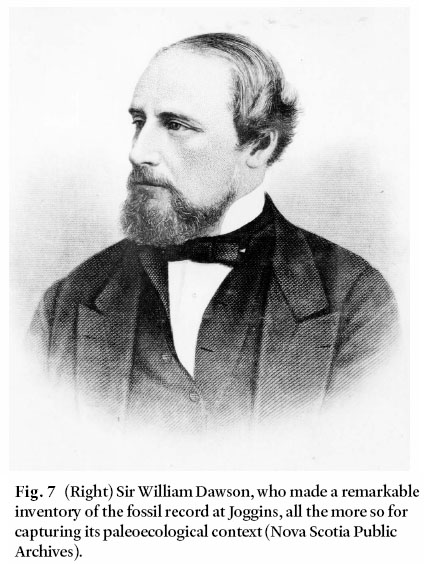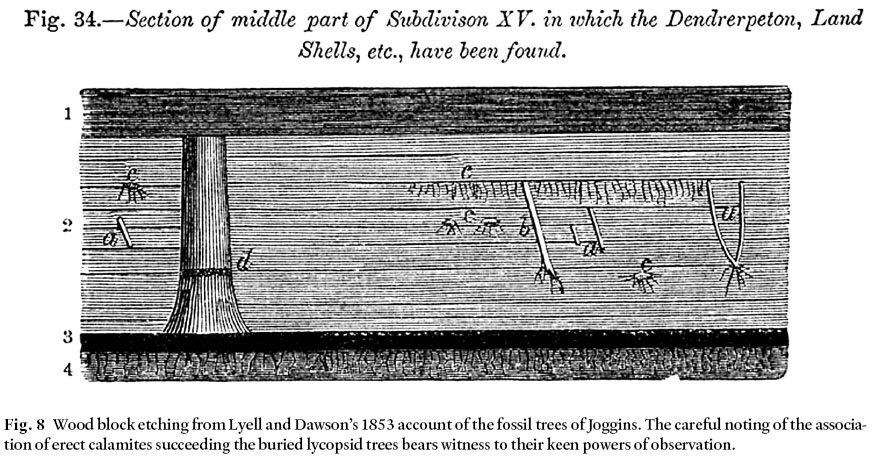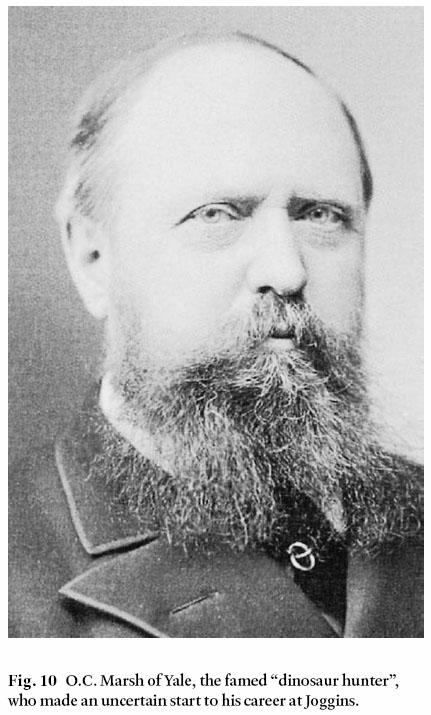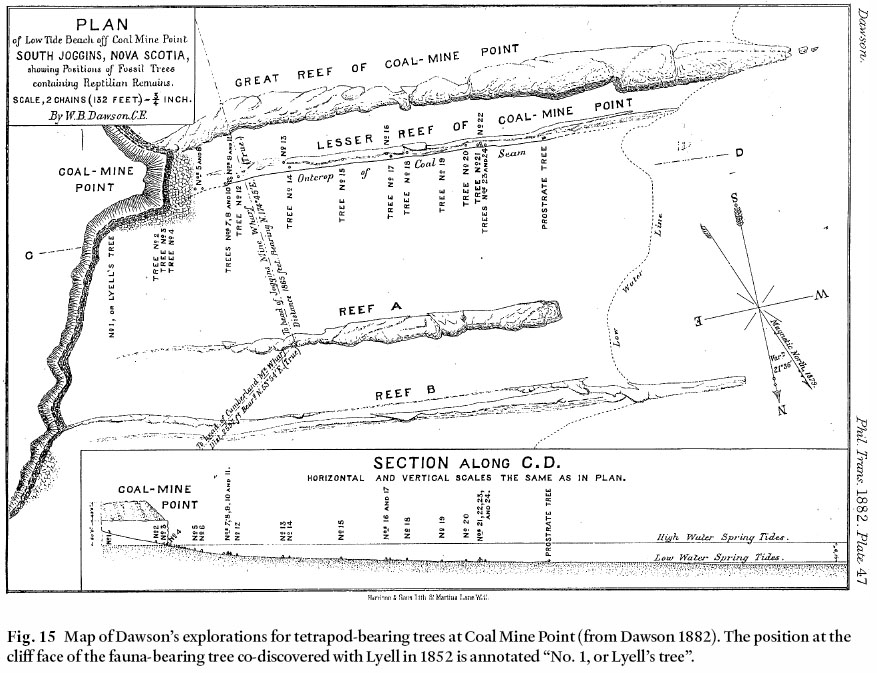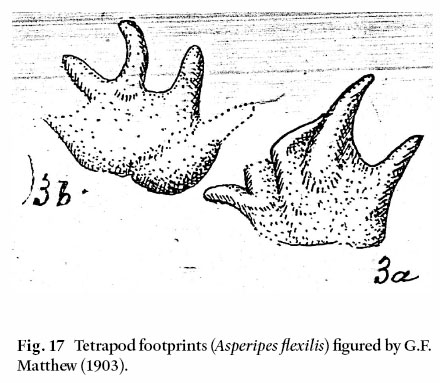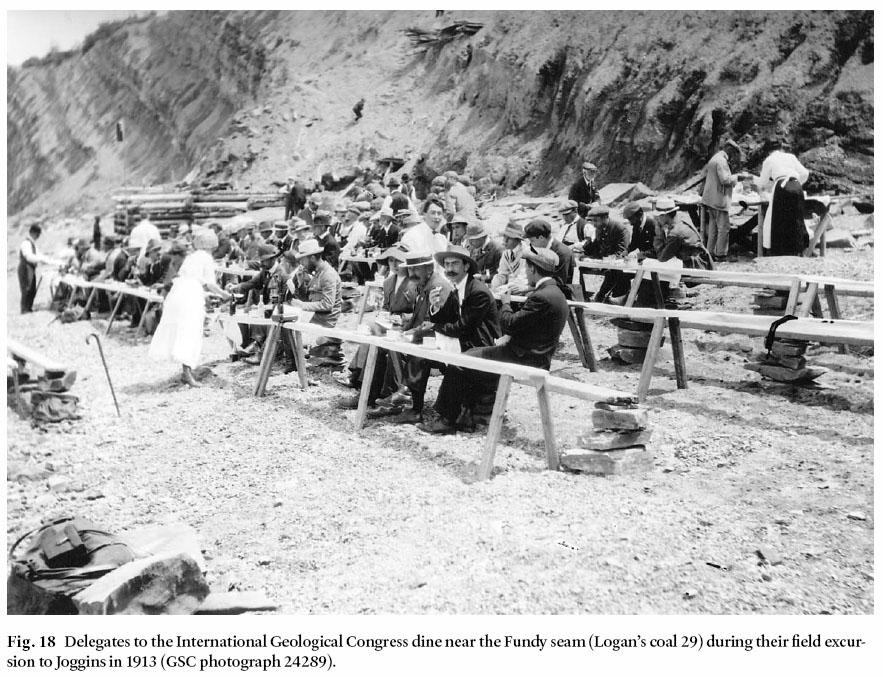“Coal Age Galapagos”: Joggins and the Lions of Nineteenth Century Geology
John H. CalderNova Scotia Department of Natural Resources, P.O. Box 698, Halifax, Nova Scotia, B3T 1S8, Canada <jhcalder@gov.ns.ca>
Date received: 21 December 2005 ¶ Date accepted: 24 February 2006
ABSTRACT
The celebrated coastal section at Joggins, Nova Scotia, has played a seminal role in the development of the Earth Sciences, figuring in the careers of such lions of Nineteenth Century science as Lyell, Dawson, Darwin, Logan, Marsh, Gesner, Agassiz, Wyman and Owen, among others. The story that unfolds is not only one of scientific discovery, but one of enlightening interactions between the players that brings to life these personalities, their debates and, for some, their personal agendas. The “marvellous chapter of the big volume” of Earth’s history recorded in the sea cliffs at Joggins served as a “Coal Age Galapagos” for Lyell, Darwin, Dawson and others, furthering their case for geological and evolutionary principles that continue to inform scientific and popular views today. Coincidental with Lyell’s appearance on the scene, Logan undertook at Joggins one of the first field projects of the Geological Survey of Canada. Against the backdrop of advancing scientific thought and positions, a penny opera of professional one-upmanship was played out. Gesner sought reprimand of Lyell from Murchison, President of the Geological Society for misleading Nova Scotia’s geologists; Owen, who earlier coined the word “dinosaur”, beat Lyell and Dawson in naming their own discovery; while a young O.C. Marsh, presaging his intensely competitive dinosaur battles with Edward Cope, arrived at Joggins from Yale hot on Lyell and Dawson’s trail, only to be duped by a worldly traveller ready to oblige his desire for fame. Above all others, the work of Dawson in describing the fossil record and its ecological context established a lasting legacy of relevance for the Joggins cliffs.RÉSUMÉ
Le célèbre secteur côtier de Joggins, en Nouvelle-Écosse, a joué un rôle majeur dans l’essor des sciences de la terre : il figure parmi les carrières de plusieurs personnages scientifiques du 19e siècle, tels que Lyell, Dawson, Darwin, Logan, Marsh, Gesner, Agassiz, Wyman et Owen, entre autres. L’histoire des lieux ne se limite pas à une découverte scientifique; elle relate des interactions instructives entre les protagonistes mettant au jour ces personnalités, leurs débats et, dans certains cas, leurs priorités personnelles. Le « merveilleux chapitre du grand volume » de l’histoire de la terre, enregistré dans les falaises de Joggins, a constitué un « genre de Galapagos de l’âge du charbon » pour Lyell, Darwin, Dawson et d’autres : il a soutenu les principes géologiques et les principes de l’évolution qu’ils avançaient et sur lesquels continuent de s’appuyer aujourd’hui les opinions scientifiques et populaires. En même temps que Lyell apparaissait sur la scène, Logan entreprenait à Joggins l’un des premiers projets de la Commission géologique du Canada sur le terrain. Avec le désir de faire progresser la pensée et les positions scientifiques en toile de fond, un opéra aux nombreux rebondissements s’est alors joué entre chercheurs professionnels. Gesner a demandé à Murchison, président de la Société géologique, que Lyell soit réprimandé pour avoir induit en erreur les géologues de la Nouvelle-Écosse. Owen, qui avait antérieurement avancé le terme de « dinosaure », a battu Lyell et Dawson en baptisant leur propre découverte. Cependant, un jeune O. C. Marsh, pressentant ses luttes profondes intensément compétitives avec Edward Cope, arrivait à Joggins en provenance de Yale, tout enthousiaste de s’engager dans le sillage de Lyell et de Dawson, mais seulement pour être dupé par un voyageur d’expérience prêt à se plier à son désir de célébrité. Émergeant au-dessus de tous les autres, les travaux réalisés par Dawson pour décrire les fossiles présents et leur contexte écologique ont implanté un héritage durable et pertinent par rapport aux falaises de Joggins.Traduit par la redaction]INTRODUCTION
1 The Joggins coastal section has long been heralded as the most outstanding section of Carboniferous strata in the world (Lyell 1871), a distinction now recognized with its placement on Canada’s Tentative List of future World Heritage Site nominees (Parks Canada 2004). It is the coincidence of Earth history recorded at this special place and the instruction that it has provided in the development of some of the seminal scientific principles of earth and biological sciences that raises Joggins to the rank of “most outstanding example in the world” of the Coal Age. This paper, compiled in the course of preparing the case for World Heritage inscription, brings together for the first time an evocation of this rugged place and the labours and interactions of some of the leading scientific thinkers of the Nineteenth Century.
BEGINNINGS
2 Long before the beginnings of the science of geology, the Mi’kmaq people of Atlantic Canada named this place. The earliest record of their place name appears on the 1735 map of George Mitchell and Edward Amhurst (Public Records Office, Kew Maps, MPG 972, Fig. 1) as “Grand Nyjagon” (J. Dawson 1988). The place name has been interpreted since as Chegoggin – “place of the fishing weirs” (Hamilton 1978) or Chegoggins – “the great encampment” (Brown 1922 and Mi’kmaq elders via Gerald Gloade, personal communication, 2005). Like many other native place names, it became construed as “The Joggins”, and later, in the time of the earliest geological visitors, to “The South Joggins” (“The North Joggins” being across Chignecto Bay at Cape Maringouin, New Brunswick (Barlow et al. 1886), the twin names likely coming from the quarrymen working both shores for grindstones). Coal was mined from the cliffs of Joggins by the French, long before any written reference to its geology in English. Archaeological investigations at Port Royal, some hundred kilometres farther down the Bay of Fundy, suggest that the first forges of the New World in North America were fuelled by the coal beds of Joggins in the earliest years of the Seventeenth Century (Brigitta Wallis, personal communication, 1996; Rebecca Duggan, personal communication 2004). Over a century later, the fires of the French garrison at Fort Beausejour at the head of the Bay continued to be stoked by coal worked from the Joggins cliffs.
Fig. 1 The earliest known map to record a place name for Joggins, given as the Mi’kmaq name “Grand Nyjagon”, by George Mitchell and Edward Amhurst, 1735. “Coal cliffs” are marked immediately to the southwest. Note that north is to the left of the map, as indicated by the compass rose. (Public Records Office, Kew Maps, MPG 972)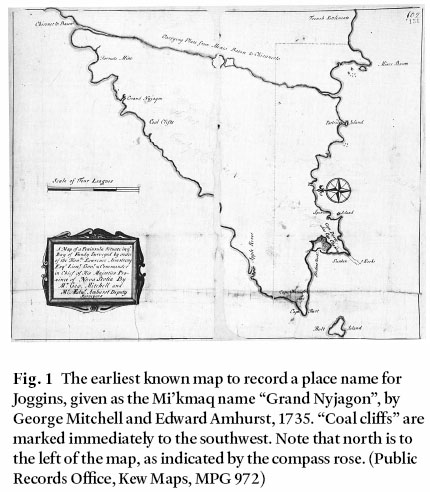
Display large image of Figure 1
3 Accounts of the geology of the celebrated coastal section at Joggins first appear in the published literature in 1828–1829, by Americans C.T. Jackson and F. Alger, and by Richard Brown and Richard Smith, managers for the General Mining Association in the Sydney and Pictou coalfields (Brown and Smith in Haliburton’s “Nova Scotia”, 1829). Brown and Smith’s astute account is the first stratigraphic reconstruction of the section and the first to document the standing fossil trees and their implications for subsidence of the Earth’s surface, whereas Jackson and Alger (1828) was strictly a geographic travelogue. In 1836, Abraham Gesner (Fig. 2), later inventor of a process to distil kerosene from coal oil, described Joggins in his typically effusive style as “… the place where the delicate herbage of a former world is now transmuted in stone.” Ever the advocate, Gesner’s exhortations of the Provincial government brought pressure to bear on the General Mining Association of London, who opened their first operation at Joggins in 1847 (Goudge 1945).
THE ARRIVAL OF LYELL
4 July 1842 saw the first visit to Joggins by Sir Charles Lyell, a side excursion from his first trip to the United States and the Province of Canada in 1841–1842. Lyell (Fig. 3), then 45 years old and near the pinnacle of his career, had just nine years earlier published the first edition of his seminal work “Principles of Geology” (1830–33), which more than any other work had defined geology as a science. Moreover it provided the temporal backdrop for the theories of a young Charles Darwin, who was presented a copy of the first volume (1830) as a parting gift by his father as he embarked on the historic voyage of The Beagle in 1831. Lyell was drawn to the fossil forests of Joggins not out of singular interest in the trees, but for their implications for his principles of basin subsidence and his theory on the terrestrial origin of coals (see Fig. 4). The context that the section provides the fossils in the cliffs of Joggins continues to be one of its most outstanding attributes (Falcon-Lang and Calder 2004). Preparing for his first trip to America in 1841, Lyell later recalled thatI was particularly desirous, before I left England, of examining the numerous fossil trees alluded to by Dr. Gesner as imbedded in an upright posture at many levels in the cliffs of the South Joggins, near Minudie.The first allusion to the trees which I have met with, is that published in 1829 by Mr. Richard Brown, in Halyburton’s Nova Scotia, and he attributed their fossilization to the inundation of the ground on which the forests stood. I felt convinced that, if I could verify the accounts of which I had read, of the superposition of so many different tiers of trees, each representing forests which grew in succession on the same area, one above the other; and if I could prove at the same time their connexion with seams of coal, it would go farther than any facts yet recorded to confirm the theory that coal in general is derived from vegetables produced on the spots where the carbonaceous matter is now stored up in the earth. Travels in North America (1845) pp. 177–178
Fig. 2 Abraham Gesner, who described Joggins as “the place where the delicate herbage of a former world is now transmuted to stone”, and who first escorted Lyell to Joggins in 1842.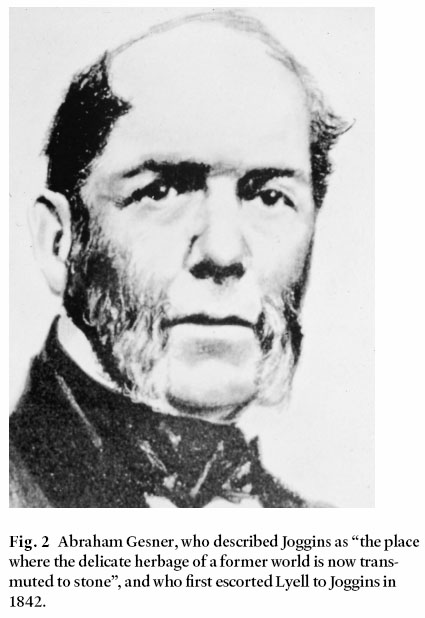
Display large image of Figure 2
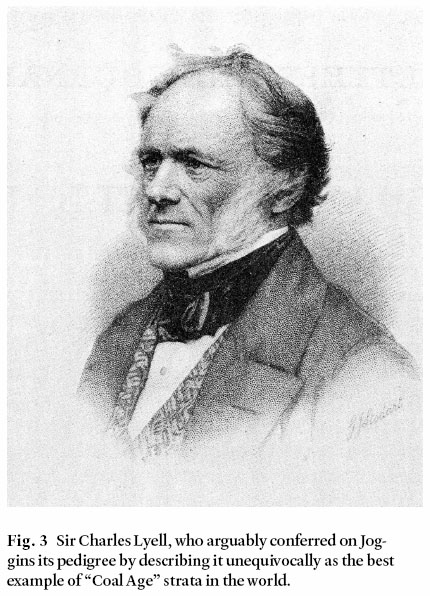
Display large image of Figure 3
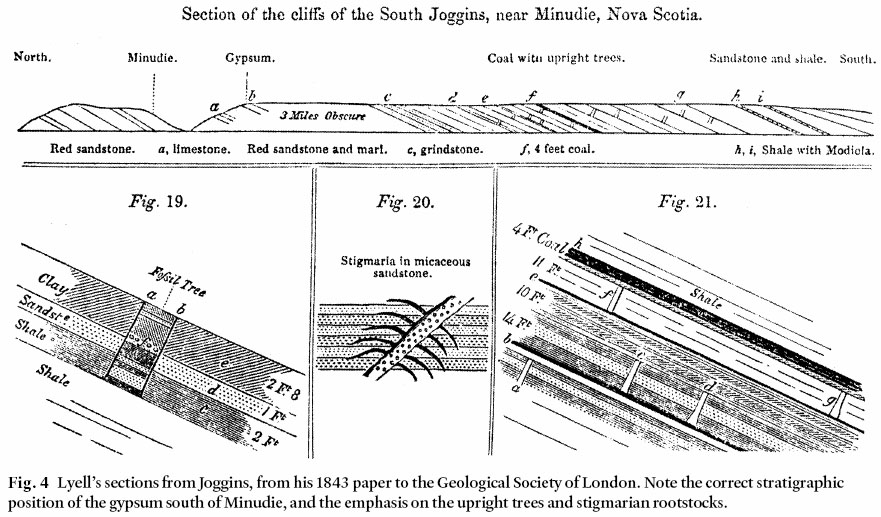
Display large image of Figure 4
5 Sir William Dawson, late in his life, recalled Lyell’s arrival as a pivotal date in geology for Joggins and for the region: and so it was. 1842 was the year that brought to Joggins not only Lyell, but also William Logan and about the same time, a young student home from Edinburgh, J. William Dawson, to this celebrated place. Following a wild sail across the Minas Basin, Lyell was met at Parrsboro by Gesner, who had a medical practise there; from there they continued the journey north to Joggins (Lyell 1845). Lyell was not to be disappointed. In a letter to his sister of 30 July 1842, he wrote, “My dear Marianne, — We have just returned from an expedition … whither I went to see a forest of fossil coal-trees — the most wonderful phenomenon perhaps that I have seen.…” Soon after, in a letter dated 9 April 1843, Lyell alerted Darwin of his forthcoming paper on the erect trees of Joggins, to be read before the meeting of the Geological Society in London. Darwin would take note.
6 Lyell once wrote “I never travelled in any country where my scientific pursuits seemed to be better understood, or were more zealously forwarded, than in Nova Scotia …” (1845, p. 229–230). Chief among these kindred spirits was a young Dawson; Dr. Gesner, on the other hand, was not making it easy for himself to be included in said company. Gesner, preparing to publish his geological map of Nova Scotia with the Geological Society in London, was unhappy that Lyell disagreed with his interpretation of the stratigraphic succession of Carboniferous strata in Nova Scotia (Fig. 4), specifically, the position of the gypsum now assigned to the Windsor Group, which Gesner (1843) erroneously held to be younger than the Coal Measures. In a letter to Roderick Murchison (President of the Geological Society), read before the Society in May 1845, Gesner sought a reprimand of Lyell for having “misled” the geologists of the day with his stratigraphy. Ironically, Gesner’s map and accompanying memoir (Gesner 1843) and Lyell’s contrary position (Lyell 1843) are recorded for posterity, back-to-back in volume 4 of the Proceedings of the Geological Society.
LOGAN AND THE FIRST FIELD PROJECTS OF THE GEOLOGICAL SURVEY OF CANADA
7 In 1843, the year following Lyell’s arrival on the scene at Joggins, Sir William Logan (Fig. 5) undertook the daunting bed-by-bed measurement of the Joggins section, measuring in total 14 570 feet, 11 inches (Logan 1845). His work together with Alexander Murray’s transect from Lake Erie to Georgian Bay (Murray 1845) comprised the first field projects of the nascent Geological Survey of Canada, with Logan as its first Director. Logan’s feat is all the more remarkable in that he completed his log of the section (Fig. 6) in less than one week (Rygel and Shipley 2005), as he set off for the Gaspé in his search for strategic deposits of coal in the new Province of Canada (Harrington 1883). In his memoir, Sir William Dawson noted the very different personalities of Lyell and Logan: “Logan and Lyell, both able geologists, were men of entirely different stamps. The former was all for observation, measurement, and careful plotting and sketching, and therefore admirably fitted for the work of a detailed survey; the latter observant, yet always full of thought and compassion, and endeavouring to realize on the spot the relations of what he saw” (Dawson 1901, p. 61). Logan’s impressive achievement served as the reference section for Joggins for 150 years, only recently being superseded (Davies et al. 2005: Calder et al. 2005a).
LYELL, DAWSON AND THE TREE STUMP FAUNA
8 In 1852, on his third trip to America, Lyell made his second excursion to Joggins, this time accompanied in the field by a 32-year-old J.W. Dawson (Fig. 7). Their goal was to investigate “the peculiar circumstances which favoured the preservation of so many fossil trees” (Lyell and Dawson 1853). Dawson and Lyell made their re-acquaintance in Halifax in early September and set out for Joggins, a two day journey by stage coach. In a letter of 12 September, Lyell wrote, “Dawson and I set to work and measured foot by foot many hundred yards of the cliffs, where the forests of erect trees and calamites most abound. … I never enjoyed the reading of a marvellous chapter of the big volume more” (see Fig. 8). In total, Dawson and Lyell re-measured 2800 ft. of Logan’s section, including the entire coal measures of Logan’s Division IV.
9 They would also make one of the most famous of fossil discoveries — tetrapods (amphibians and later by Dawson alone, reptiles) within the erect fossil trees, together with millipedes and the earliest land snails. Dawson later recounted Lyell’s excitement at their discovery: “I well remember how, after we had disinterred the bones of Dendrerpeton from the interior of a large tree on the Joggins shore, his thoughts ran rapidly over all the strange circumstances of the burial of the animal, its geological age, and its possible relations to reptiles and other animals, and he enlarged enthusiastically on these points, till, suddenly observing the astonishment of a man who accompanied us, he abruptly turned to me and whispered, ‘The man will think us mad if I run on in this way’.” Lyell took the specimens with him to Boston, where they were examined by Louis Agassiz and Jeffries Wyman of Harvard. Lyell and Dawson waited excitedly for their decision on what they grew to hope were “reptilian” remains, their hopes rising and falling with each revelation. (Note that in the mid-Nineteenth Century, the term “reptile” included amphibians, in much the same sense as the term “tetrapod” is employed today; Carroll 1982). In a letter to Dawson written 6 November 1852 (K.M. Lyell 1881), Lyell related the excitement: My dear Sir, — I have very good news to tell you. Agassiz only conjectures that hollow-tree Joggins animal is a coelocanth fish.… Wyman begins to suspect an ichthyic reptile allied to Siren, Proteus anguinus (Nemobranchus?), &c., as he says there is a bone in them more like it. So much for our principal skeleton. But you will be delighted to hear that in the same stone Wyman has worked out part of a vertebral column, seven vertebrae in a series, and three other detached ones of the same dorsal and lumbar region, belonging to a distinct creature, and which he at once pronounced a salamander from the articulating surface of the ball-and-socket joints, &c. Afterwards, when it was shown to Agassiz, he exclaimed, ‘This is more reptilian than anything I ever saw in the coal!’ I now begin to regret that we left a single fragment of the stone on the beach. For Wyman worked this treasure out of a most unpromising stone, like many which I threw away. Latest intelligence — Dr. Wyman has just been here with great news. The first bone which we found is clearly not the hyoid bone of a fish, but the iliac bone of a reptile. Do not say anything about it, as every hour he is advancing.… So we have two reptiles according to this, and as only four individuals were previously known in the coal of the whole world, I hope we have added 33 1/3 per cent. at one stroke to the reptilian paleontology of that era. Believe me, my dear sir, ever truly yours,Charles Lyell
10 Lyell and Dawson’s discovery was first announced through the “Lowell lectures” given by Lyell a few weeks later in Boston (Dott 1998). Arriving back in England, Lyell and Dawson’s “Reptile of the Coal Age” was quickly named Dendrerpeton acadianum, not by the discoverers but to Dawson’s chagrin by Sir Richard Owen (Fig. 9), that great usurper of names and credit (see Chapter 6 of Bryson 2003), in a postscript that he added to their discovery paper read before the Geological Society on 19 January 1853 (Owen 1853). Less than a year later, on New Year’s Eve 1853, Owen would dine at Crystal Palace in London inside a partially completed Iguanodon, the first ever reconstruction of a dinosaur. Owen would claim his seat at the head of the table, having earlier in 1841 laid claim also to the name “Dinosauria”. With Lyell and Dawson, however, rest the honours of one of the most celebrated of all fossil discoveries.
Fig. 5 Sir William Logan, whose bed-by-bed measurement of the Joggins section in 1843 constituted one of the two initial field projects of the fledgling Geological Survey of Canada (GSC Photograph 68772).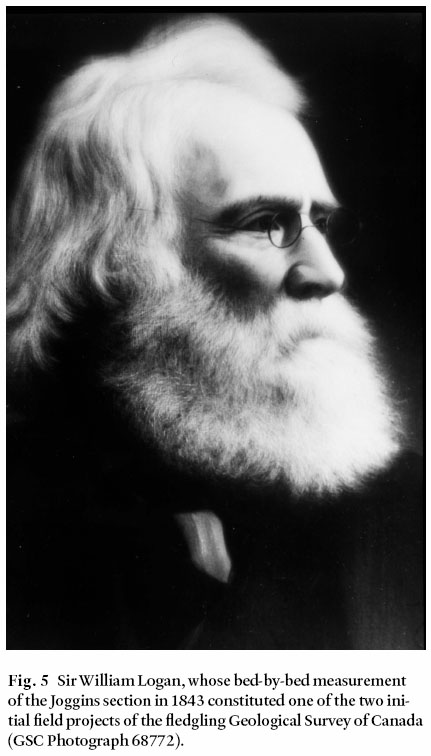
Display large image of Figure 5
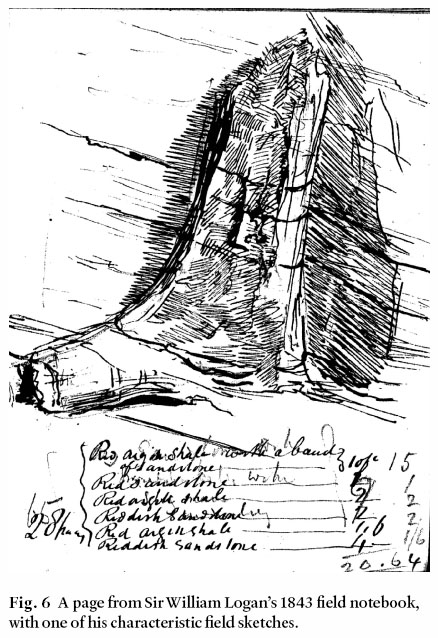
Display large image of Figure 6
O.C. MARSH AND EOSAURUS ACADIANUS
11 The fame of Joggins quickly spread, made all the more accessible with the first printing of Dawson’s Acadian Geology in 1855. One of the first to be drawn to Joggins from beyond the immediate circle of Lyell’s collaborators heralded from the United States. In 1855, O.C. Marsh (Fig. 10) was a wealthy young man of 24 just entering Yale when he decided to embark on the voyage north to Joggins. One can speculate that word of Lyell and Dawson’s discovery sparked hope in the zealous “dinosaur hunter” of later years of making a name for himself in paleontology. Marsh’s purported “discovery” of two large vertebrael centrae (Fig. 11) was proclaimed “Eosaurus acadianus”, but in an uncharacteristic show of restraint not until 1862, after input from Agassiz (1862). Dawson (1868, p. 382) remarked with his trademark insight and restraint on the uncanny resemblance of Eosaurus to the Mesozoic marine reptile Ichthyosaurus. Legend has it that Marsh’s fossil actually was purchased from a fellow seafarer who convinced O.C. of its origins at Joggins (D. Baird, written communication, 1994). Subsequent vertebrate paleontologists (Romer 1945; Carroll et al. 1972; as well as Baird) widely hold the vertebrae to be those of an icthyosaur from Lyme Regis, Dorset, home to the seaside fossil shop of Mary Anning.
Fig. 9 Sir Richard Owen, first keeper of the British Museum of Natural History, and a scientist with a compulsive nature for claiming ownership of others’ discoveries.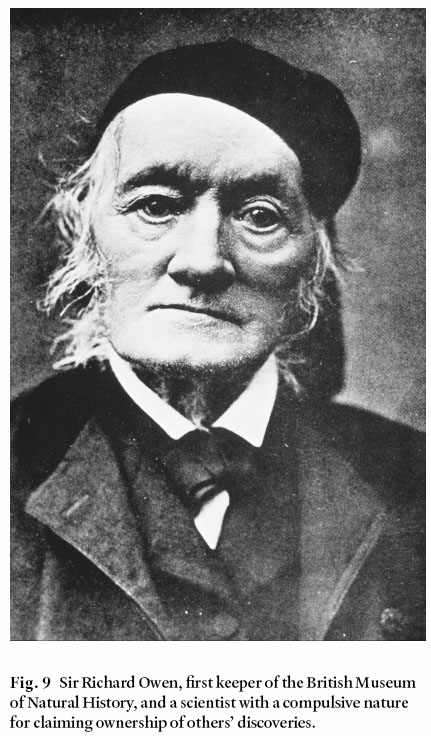
Display large image of Figure 9
THE BIG PICTURE: LYELL, DARWIN AND DAWSON ON EVOLUTION
12 Lyell was delighted with his discovery with Dawson of Coal Age “reptiles” largely because it argued against the progression of fishes in the Paleozoic to reptiles in the Mesozoic (Thackray 1998), part of his long-standing campaign against the proponents of catastrophism (Bryson 2003). Charles Darwin (Fig. 12), in The Origin of Species (1859) drew on the completeness of exposure at Joggins and the recurrence of the fossil forests to illustrate that the fossil record is inherently incomplete. What at first may seem a paradox was, in fact, a shrewd, pre-emptive argument against critics of gradual and progressive evolution. Darwin argued that even in the unrivalled exposures at Joggins (Lyell 1871), where fossil forests appear at no less than 68 horizons, the intervening beds theoretically could hide “the fine intermediary gradations which must on my theory have existed between them”, with the result that the fossil record generally gives the misleading appearance of “abrupt, though perhaps very slight, changes of form.” (Darwin 1859, Ch. IX, Imperfection of the Geological Record, p. 296.)
13 Dawson continued to argue the case for Lyell, his close friend, mentor and benefactor. In 1863 he published Air-Breathers of the Coal Period, (subtitled A descriptive account of the remains of land animals found in the coal formation of Nova Scotia with remarks on their bearing on theories of the formation of coal and of the origin of the species), which as the complete title reveals, was in part a counterpoint to Darwin’s Origin of Species (1859). Dawson advocated that the discovery of essentially modern, conservative forms such as the land snail Dendropupa (Fig. 13), virtually unchanged over millions of years, argued against Darwinian progressive change — imperfections in the geological record aside. Bishop Samuel Wilberforce (1860, p. 244) in his review and criticism of Origin of Species had already taken obvious pleasure in chiding Darwin about “this miserable little Dendropupa (Fig. 14). It is clear that Dawson never accepted Darwin’s transmutation of species (Dawson 1893), even though he did recognize the concept of deep time and the slow progress of the appearance of progressively higher forms of life in the fossil record, and so could not be called a creationist in today’s sense. Indeed, it is one of the great ironies in the history of science that Dawson fought to convince his contemporaries that life had microbial origins far deeper in time than most were willing to accept: his Eozoon canadense (Dawson 1875). Historians (e.g. O’Brien 1971) have done Dawson disservice in dismissing his challenges to Darwin as religious myopia and not considering them further. Like all his work, Dawson was a careful observer and documenter of geologic phenomena. His observation, for example, that conservative forms such as Dendropupa persist unchanged for long expanses of time presaged later modification to evolutionary theory expressed in the “tempo and mode” of Simpson (1944) and “punctuated equilibria” of Gould and Eldredge (1977), but which would have to await the passage of a century for wide acceptance (Rolfe 1982; Carroll 1982).
Fig. 12 Charles Darwin, who crafted a pre-emptive argument on the incomplete nature of the fossil record, using Joggins as an example. Darwin also was compelled to address the existence of the land snail Dendropupa at Joggins. (Elliot and Fry portrait.)THE ORIGIN OF COAL
“I shall never rest easy in Down church-yard,without the problem be solved by someone before I die.”
Charles Darwin in a letter to J.D. Hooker,
10 May 1848
(DAR 114.2: 112 in Burkhardt and Smith 1988).
14 Debate on the origin of coal, the fuel of the Industrial Revolution, revolved very much around the Joggins section (see Scott 1998). Lyell cited this as one of his main reasons for first visiting the cliffs in 1842 and it was the subject of one his Lowell lectures delivered in Boston and repeated in New York and Philadelphia during his first trip to America (Dott 1998). Coal beds remained enigmatic to many scientists of the day (Horner 1846), some of whom, including Darwin (correspondence of 19 May 1846; DAR 114.2: 62–62b in Burkhardt and Smith 1987), speculated that their great areal extent necessitated a submarine origin. Darwin’s suggestion to Joseph Hooker that the upright trees of Joggins and elsewhere might also have been submarine by association, having grown at depths of 5 to 100 fathoms (DAR 114.2: 89), drew a “savage onslaught” from his trusted confidant, cited in Darwin’s rebuttal letter of 6 May 1847 (DAR 114.2: 91 in Burkhardt and Smith 1988). Dawson (1865), like Lyell, correctly advocated a terrestrial plant origin for coal beds. Thomas Huxley, “Darwin’s bulldog”, however, drew sweeping conclusions – a position consistent with Darwin’s – that coal beds were derived from subaquatic concentrations of spores. Huxley (1897) eventually acquiesced to Dawson, citing his command of the subject, but continued to stress the significance of spore cases, as if to keep Darwin’s torch alight.
Fig. 13 Wood block etching of the earliest land snail Dendro-pupa vetusta, an illustration that bears witness to Dawson’s prowess with the microscope (from Acadian Geology, 1855).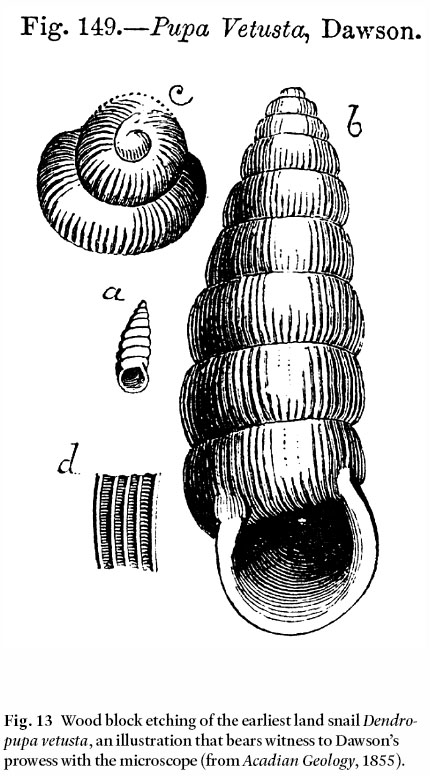
Display large image of Figure 13
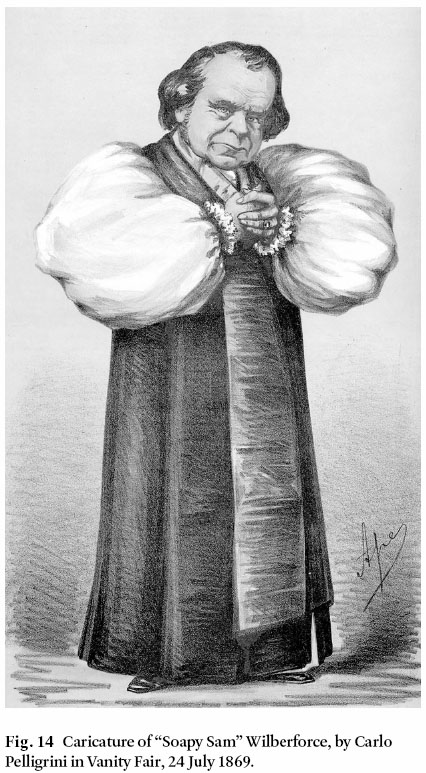
Display large image of Figure 14
15 The first convincing argument for the terrestrial origin of coal had come from Logan’s observations (1841) that Stigmaria were the roots of lycopsid trees in their original position of growth. Logan felt that Lyell had failed to credit his observations, however, which he had provided Lyell by letter from Halifax (see Dott 1996, p. 139). Lyell’s defense was that his Lowell lecture on the subject, given after their correspondence, was actually written beforehand. However, Logan was unconvinced and, in a letter to Henry De la Beche of 3 December 1841 (H.T. De la Beche Papers, National Museum of Wales, NMW 84.20G.D876, cited in Dott 1996), wryly observed: “I see he mentions that I had made independent observations on Nova Scotia. How the devil he knew that before I told him I cannot imagine.” For Darwin, however, it was not the in situ nature of Stigmaria, but rather the discovery of terrestrial fauna within the upright trees at Joggins (Dawson 1860) that finally persuaded him of the terrestrial origin of coal, in essence “fossil peat”, and of the fossil trees: in a letter of 22 May 1860 to Lyell (American Philosophical Society 213 in Burkhardt et al.1993), he exclaimed “What a fact about the Coal Land Shells!!!”. Darwin may rest easy.
DAWSON’S LABOUR OF LOVE
16 Dawson revisited the site of his initial discovery with Lyell of Dendrerpeton over the course of the next few years, and in 1859 reported to the Geological Society yet another discovery, the significance of which has continued to grow with time. Hylonomus lyelli, meaning “forest dweller”, named in honour of his mentor and friend, Sir Charles, a century and a half later was proclaimed Nova Scotia’s Provincial fossil and remains the earliest known amniote in the fossil record (Carroll 1964, 1970; Reisz 1997; Clack 2002). (Hylonomus was briefly usurped by Westlothiana lizzeae, an older tetrapod known from the Visean of Scotland, but which is now widely considered to represent a more primitive, stem amniote; Reisz 1997; Clack 2002).
17 In 1877, armed with a grant of £50 from the Royal Society, and with the assistance — and explosives — of the mining company at Joggins, Dawson set out to investigate the tree-entombed tetrapods with vigour (Fig. 15). Dawson (1882) exposed an entire fossil forest horizon comprising 25 lycopsid trees entombed in the “Lesser Reef of Coal Mine Point”. Incredibly, 15 — over half — were productive, yielding more than 100 individual tetrapods from this one concentrated
18 Lagerstätten, which remains the most significant single collection of Paleozoic terrestrial tetrapods in the world. The curious circumstances of the entombment of these denizens of the Coal Age forests has continued to enthral scientists and the public. Lyell and Dawson (1853) early on ascribed their occurrence to denning, pitfall, or the possibility that the animals had been washed into the buried hollow trees. Dawson (1891a) ultimately came to favour the pitfall theory, which has been figured in countless texts on the history of life, although recent research (Calder et al. 2005b) points to another of Lyell and Dawson’s original hypotheses: denning.
19 Much of our knowledge of the fossil record at Joggins derives from the lifelong work of Dawson, which encompassed a broad range of paleontological disciplines including plants, tetrapods, fishes, terrestrial and aquatic invertebrates, and trace fossils. Dawson sought the collaboration of peers on both sides of the Atlantic, including among others Louis Agassiz and S.H. Scudder of Harvard, and their colleague A.A. Gould, Joseph Leidy of the Academy of Natural Sciences, Philadelphia, J.W. Salter at the Geological Survey of Great Britain and T.P. Jones, fellow of the Geological Society and professor at Sandhurst.
20 Dawson was a pioneer in the field of terrestrial paleoecology (Falcon-Lang and Calder 2005). In a letter written 13 August 1868 (cited in Sheets-Pyenson 1995), Dawson commiserated with Lyell on the lack of field investigation that typified and hobbled paleontologists of the day, offering that advances would come by careful study of “… plants as they stand in the cliffs at Sydney and the Joggins, instead of on the shelves of the British Museum.” The breadth of Dawson’s work and his careful observations of the relationships of fossils and their entombing sediments (Falcon-Lang and Calder 2005), coupled with observations by Lyell and others of modern environments, enabled him to draw astute inferences of the ancient Joggins landscape and its paleoecology: “… these beds carry our thoughts back to a period when the district was covered by a strange and now extinct vegetation, and when its physical condition resembled that of the Great Dismal Swamp, the Everglades, or the Delta of the Mississippi” (Acadian Geology, Dawson 1868, p.182). His historic diorama of the terrestrial environment and fauna at Joggins for the frontispiece of Air Breathers of the Coal Period (1863) is one of the earliest for the Paleozoic (Fig. 16). Dawson’s publications stemming from Joggins, spanning 44 years, are summarized eloquently in his opus “Acadian Geology” (1855), and updated through the addition of supplements in subsequent editions (1868, 1878 and 1891b).
Fig. 15 Map of Dawson’s explorations for tetrapod-bearing trees at Coal Mine Point (from Dawson 1882). The position at the cliff face of the fauna-bearing tree co-discovered with Lyell in 1852 is annotated “No. 1, or Lyell’s tree”.NEW CENTURIES DAWN
21 Lyell’s first impression of the coastal section at Joggins was never diminished. In discussing the coal measures of the Carboniferous in The Student’s Elements of Geology (1871), Lyell would bequeath to Joggins the following blessing: “But the finest example in the world of a natural exposure in a continuous section ten miles long, occurs in the sea cliffs bordering a branch of the Bay of Fundy in Nova Scotia.”
22 Late in his life, Dawson (1901) recalled his first visit to Joggins in the early 1840s, a memory evocative to many who have followed in his footsteps…:
23 The tide being low in the afternoon, I rose early next morning, and taking some luncheon in my basket, walked along the shore to the south-westward for several miles. I was amazed at the grand succession of stratified beds exposed as plainly as in a pictured section, and was interested beyond measure in the beds of coal, with all their accompaniments, exposed in the cliffs and along the beach, the erect trees (Sigillaria) represented by sandstone casts, and the numerous fossil plants displayed in the beds. The tide favoured my expedition, and the day was fine, though small banks of fog drifted up the bay from time to time, dissolving as they touched the cliffs, warmed by the sun. I returned in the evening to the quarrymen’s shanty, thoroughly fatigued, but loaded with fossils, delighted with the knowledge I had acquired, and with my enthusiasm for geology raised to a higher point than ever before. Such was my first visit to the celebrated coast-section of the Joggins, on which I have spent so many pleasant and profitable days.
Fig. 16 “Reptiles of the Coal Period”, one of the earliest dioramas of terrestrial life in the “Coal Age” (from Dawson 1863).
Display large image of Figure 16
24 In the twilight of Dawson’s life, the momentum of his work carried paleontology forward at Joggins. In 1893, T.C. Weston of the Geological Survey of Canada discovered one of the few taxa to escape Dawson’s eye, the large and enigmatic bivalve Archanodon, originally described as Asthenodonta by Whiteaves (1893), who the year before had described fauna from the Burgess Shale. As a new century dawned without Sir William, George Frederic Matthew, founder of the New Brunswick Museum, pursued the trackways of Lyell and Dawson’s tetrapods (Fig. 17) in a series of keynote papers (Matthew 1903, 1905) that remain definitive works in tetrapod ichnology. In 1909, the torchbearer of field work in the Carboniferous of Nova Scotia, Hugh Fletcher of the GSC, lost his life to pneumonia contracted while working the section (Zaslow 1975).
25 Research at Joggins in the Twentieth Century reflected the pragmatism and geopolitical divide of a world conflicted, with attention focusing on characterizing the coal beds that continued to be strategically important. A major focus of research was that of Walter Bell, one of the delegates to the International Geological Congress of 1913 (Fig. 18), who pursued paleobotanical studies at Joggins and elsewhere in the Carboniferous rocks of eastern Canada. Bell’s interest in the fossil plants lay chiefly in their utility in correlating the rocks of eastern Canada with, in particular, those of the European coal measures (see Calder 1998).
26 A resurgence in scientific publication at Joggins to rival that of the Nineteenth Century has waited for the passage of a century since the work of the “Lions”, and has required the collective wisdom and efforts of an informal working group drawn, as in Lyell and Dawson’s day, from both sides of the Atlantic (see Atlantic Geology volume 41, issues 2 & 3, 2005). Just as in the mid-Nineteenth Century, this work was made possible only with the return to careful, bed by bed scrutiny of this daunting section (Davies et al. 2005; Calder et al. 2005; Calder et al. 2006). The graphic logs derived from this work now serve as the reference section for specimens collected from this most outstanding exposure of the “Coal Age”.
POSTLUDE
27 The void left in the wake of Sir William’s departure, and of his contemporaries of the Nineteenth Century, is one that is impossible to measure, but more than a century later is almost palpable. How the delegates to the International Geological Congress must have longed for their guidance as they walked these shores in 1913, as we have since. They walk with us still in the mists of time that hug these magnificent cliffs, their voices mingle with the crashing waves. This paper is dedicated to their memory.
Fig. 17 Tetrapod footprints (Asperipes flexilis) figured by G.F. Matthew (1903).Fig. 18 Delegates to the International Geological Congress dine near the Fundy seam (Logan’s coal 29) during their field excursion to Joggins in 1913 (GSC photograph 24289).ACKNOWLEDGEMENTS
I would like to offer my appreciation to the many people who have helped to shed light on the history of geology at Joggins over the past 25 years, and have allowed the perspective of this synthesis to take shape. These have including Stephen Archibald, Don Baird, Bob Carroll, Howard Falcon-Lang, Tim Fedak, Laing Ferguson, Martin Gibling, Gerald Gloade and elders of the M’ikmaw First Nation, Bob Grantham, the late Peter Hacquebard, Brian Hebert, Ernie Hennick, Heidi MacDonald, J. Lynton Martin, Ley Missidailis, Donald Reid, Andrew Scott, the late Susan Sheets-Pyenson, Deborah Skilliter, Charles Smith, the late John Thackray, Harry Thurston, Brian Todd, Robert Wagner and Brigitta Wallis. To those who inevitably I have not named here, I offer my apology and thanks. I would also like to thank the Martin Rudwick for perusing an early draft, to reviewers Michael Rygel and Christy Vodden for their thoughtful, helpful reviews, and to Rob Fensome for his characteristic care in improving the manuscript as editor. I wish to thank David McMullin for his careful attention in preparing the manuscript for publication.REFERENCES
Agassiz, L. 1862. New sauroid remains (from Nova Scotia). American Journal of Science, 33, p. 138.
Barlow, S., McOuat, W., & Ells, R.W. 1886. Province of Nova Scotia and part of New Brunswick. Geological and Natural History Survey of Canada Map.
Brown, R., & Smith, R. 1829. Geology and mineralogy. In A historical and statistical account of Nova Scotia, 2, section III. Edited by T.C.Haliburton, Joseph Howe, Halifax, pp. 414–453.
Brown, T.J. 1922. Place-names of the Province of Nova Scotia. Royal Print & Litho, Halifax, 158 p.
Bryson, B. 2003. A short history of nearly everything. Doubleday, Toronto, 544 p.
Burkhardt, F., & Smith, S. 1987. The correspondence of Charles Darwin, vol. 3, 1844–1846. Cambridge University Press, Cambridge, 523 p.
Burkhardt, F., & Smith, S. 1988. The correspondence of Charles Darwin, vol. 4, 1847–1850. Cambridge University Press, Cambridge, 711p.
Burkhardt, F., Porter, D.M., Browne, J., & Richmond, M. 1993. The correspondence of Charles Darwin, vol. 8, 1860. Cambridge University Press, Cambridge, 766p.
Calder, J.H. 1998. The Carboniferous evolution of Nova Scotia. In Lyell: the past is the key to the present. Edited by D. Blundell and A.C. Scott, A.C. Geological Society of London, Special Publication 143, pp. 296–331.
Calder, J.H., Rygel, M.C., Ryan, R.J., Falcon-Lang, H.J., & Hebert, B.L. 2005a. Stratigraphy and sedimentology of early Pennsylvanian red beds at Lower Cove, Nova Scotia, Canada: the Little River Formation with redefinition of the Joggins Formation. Atlantic Geology, 41, pp. 143–167.
Calder, J.H., Scott, A.C., & Milner, A.R. 2005b. The tree hollow fauna of Joggins: Ockham’s Razor fells the pitfall theory. In North American Paleontology Convention, Halifax, Nova Scotia, Programme and Abstracts. Paleobios, Museum of Paleontology, University of California, Berkeley, 25, p. 28.
Calder, J.H., Gibling, M.R., Scott, A.C., Davies, S.J., & Hebert, B.L. 2006. A fossil lycopsid forest succession in the classic Joggins section of Nova Scotia: paleoecology of a disturbance-prone Pennsylvanian wetland. Geological Society of America Special Paper 399, pp. 165–195.
Carroll, R.L. 1964. The earliest reptiles. Journal of the Linnaean Society (Zoology), 45, pp. 61–83.
Carroll, R.L. 1970. The earliest known reptiles. Yale Scientific Magazine, October, pp.16–23.
Carroll, R.L. 1982. Sir William Dawson and the vertebrate fossils of the Joggins fauna. Third North American Paleontological Convention, Proceedings v. 2, August, 1982, pp. 71–75.
Carroll, R.L., Belt, E.S., Dineley, D.L., Baird, D., & Mc-Gregor, D.C. 1972. Vertebrate palaeontology of eastern Canada. Guidebook, Excursion A59, XXIV International Geological Congress, Montreal, pp. 64–80.
Clack, J. A. 2002. Gaining Ground: the origin and evolution of tetrapods. Indiana University Press, Bloomington, Indiana, 369 p.
Darwin, C. 1859. The origin of species by means of natural selection. John Murray, London, 513 p.
Davies, S.J., Gibling, M.R., Rygel, M.C., Calder, J.H., & Skilliter, D.M. 2005. The Joggins Formation of Nova Scotia: sedimentological log and stratigraphic framework of the historic fossil cliffs. Atlantic Geology, 41, pp. 115–142.
Dawson, J. 1988. The mapmaker’s eye. Nimbus and Nova Scotia Museum, Halifax, 156 p.
Dawson, J.W. 1855. Acadian Geology: an account of the geological structure and mineral resources of Nova Scotia, and portions of the neighbouring provinces of British America. Oliver and Boyd, Edinburgh, 388 p.
Dawson, J.W. 1860. On a Terrestrial mollusk, a millepede, and new reptiles, from the Coal Formation of Nova Scotia. Quarterly Journal of the Geological Society of London, 16, pp. 268–277.
Dawson, J.W. 1863. Air-breathers of the Coal Period: a descriptive account of the remains of land animals found in the coal formation of Nova Scotia with remarks on their bearing on theories of the formation of coal and of the origin of the species. Dawson Brothers, Montreal, 81 p.
Dawson, J.W. 1865. On the conditions of the deposition of coal, more especially as illustrated by the coal formation of Nova Scotia and New Brunwsick. Quarterly Journal of the Geological Society of London, 22, pp. 95–166.
Dawson, J.W. 1868. Acadian Geology. The geological structure, organic remains, and mineral resources of Nova Scotia, New Brunswick, and Prince Edward Island. Second edition. MacMillan & Co., London, 694 p.
Dawson, J.W. 1875. The dawn of life; being the history of the oldest known fossil remains, and their relations to geological time and to the development of the animal kingdom. Dawson Bros., Montreal, 239 p.
Dawson, J.W. 1878. Acadian Geology. The geological structure, organic remains, and mineral resources of Nova Scotia, New Brunswick, and Prince Edward Island. Third edition. MacMillan & Co., London, 796 p.
Dawson, J.W. 1882. On the results of recent explorations of erect trees containing animal remains in the coal formation of Nova Scotia. Philosophical Transactions of the Royal Society of Canada, Part II, 173, pp. 621–659.
Dawson, J.W. 1891a. On the mode of occurrence of remains of land animals in erect trees at South Joggins, Nova Scotia. Transactions of the Royal Society of Canada, 9, pp. 127–128.
Dawson, J.W. 1891b. The geology of Nova Scotia, New Brunswick and Prince Edward Island or Acadian Geology. Fourth Edition. Oliver and Boyd, Edinburgh, 833 p.
Dawson, J.W. 1893. Some salient points in the science of the Earth. Hodder & Stoughton, London, 499 p.
Dawson, J.W. 1901. Fifty years of work in Canada, scientific and educational. Ballantyne, Hanson & Co., London & Edinburgh, 308 p.
Dott, R.H. Jr. 1996. Lyell in America — his influences, field work, and mutual influences, 1841–1853. Earth Sciences History, 15, pp. 101–140.
Dott, R.H. Jr. 1998. Charles Lyell’s debt to North America: his lectures and travels from 1841 to 1853. In Lyell: the past is the key to the present. Edited by D.J. Blundell and A.C. Scott. Geological Society of London, Special Publication 143, pp. 53–69.
Falcon-Lang, H.J., & Calder, J.H. 2004. UNESCO World Heritage and the Joggins cliffs of Nova Scotia. Geology Today, 20, pp. 139–143.
Falcon-Lang, H.J., & Calder, J.H. 2005. Sir William Dawson: a very modern palaeobotanist. Atlantic Geology, 41, pp. 103–114.
Gesner, A. 1836. Remarks on the geology and mineralogy of Nova Scotia. Gossip and Coade, Halifax, 272 p.
Gesner, A. 1843. A geological map of Nova Scotia, with an accompanying memoir. Proceedings of the Geological Society of London, 4, pp. 186–190.
Goudge, M.G. 1945. Joggins–River Hebert coal district (a review). Nova Scotia Department of Mines, Annual Report for 1944, pp. 152–182.
Gould, S.J., & Eldredge, N. 1977. Punctuated equilibria: the tempo and mode of evolution reconsidered. Paleobiology, 3, pp. 115–151.
Hamilton, W.B. 1978. The Macmillan book of Canadian place names. Macmillan, Toronto, 340 p.
Harrington, B.J. 1883. Life of Sir William E. Logan: chiefly compiled from his letters, journals and reports, 432 p.
Horner, L. 1846. Anniversary address of the president. Quarterly Journal of the Geological Society of London, 2, pp. 145–221.
Huxley, T.H. 1897. Discourses: biological and geological essays. D. Appleton & Co., New York, 388 p.
Jackson, C.T., & Alger, F. 1828. A description of the mineral-ogy and geology of a part of Nova Scotia. American Journal of Science and Arts, 14, pp. 305–330.
Logan, W.E. 1841. On the character of the beds of clay lying immediately below the coal seams of South Wales. Proceedings of the Geological Society of London, 3, pp. 487–492.
Logan, W.E. 1845. A section of the Nova Scotia coal measures as developed at Joggins on the Bay of Fundy, in descending order, from the neighbourhood of the west Ragged Reef to Minudie, reduced to vertical thickness. Geological Survey of Canada Report of Progress for 1843, Appendix W, pp. 92–153.
Lyell, C. 1830–33. Principles of geology, being an attempt to explain the former changes of the Earth’s surface, by reference to causes now in operation. 3 vols. Murray, London.
Lyell, C. 1843. On upright fossil trees in the coal strata of Cumberland, Nova Scotia. Silliman’s Journal, 45, p. 353. Lyell, C. 1845. Travels in North America; with geological observations on the United States, Canada, and Nova Scotia, v. 2. John Murray, London, 272 p.
Lyell, C. 1871. The student’s elements of geology. John Murray, London, 624 p.
Lyell, C., & Dawson, J.W. 1853. On the remains of a reptile (Dendrerpeton acadianum Wyman and Owen), and of a land shell discovered in the interior of an erect fossil tree in the coal measures of Nova Scotia. Quarterly Journal of the Geological Society, London, 9, pp. 58–63.
Lyell, K.M. 1881. Life, letters and journals of Sir Charles Lyell, Bart. Volume 2. John Murray, London, 489 p.
Marsh, O.C. 1862. Description of the remains of a new enaliosaurian (Eosaurus acadianus), from the coal formation of Nova Scotia. American Journal of Science and Arts, 34, pp. 1–16.
Matthew, G.F. 1903. On batrachian and other footprints from the Coal Measures of Joggins, N.S. Natural History Society of New Brunswick, Bulletin 21, pp. 103–108.
Matthew, G.F. 1905. New species and a new genus of batrachian footprints of the Carboniferous system in eastern Canada. Royal Society of Canada, Proceedings and Transactions, 10, pp. 77–121.
Murray, A. 1845. Report of Alexander Murray, Esq., Assistant Provincial Geologist, addressed to W.E. Logan, Esq., Provincial Geologist, March 14th 1844. In Message from His Excellency the Governor General, with reports on a geological survey of the Province of Canada, presented to the House on 27th January, 1845. Lovell and Gibson, Montreal.
O’Brien, C.F. 1971. Sir William Dawson, a life in science and religion. Memoirs of the American Philosophical Society, 84, 207 p.
Owen, R. 1853. Notes on the above-described fossil remains. Quarterly Journal of the Geological Society of London, 9, pp. 66–67.
Parks Canada 2004. Canada’s tentative list for World Heritage Sites. Parks Canada, Ottawa, 46 p.
Reisz, R.R. 1997. The origin and early evolutionary history of amniotes. Trends in Ecology and Evolution, 12, pp. 218–222.
Rolfe, W.D.I. 1982. Dawson’s invertebrate ‘Air-Breathers of the Coal Period’ today. Third North American Paleonto-logical Convention, Proceedings, Volume 2, August, 1982, pp. 435–439.
Romer, A.S. 1945. Vertebrate paleontology. 2nd Edition. University of Chicago Press, Chicago, 687 p.
Rygel, M.C., & Shipley, B.C. 2005. “Such a section as never was put together before”: Logan, Dawson, Lyell and mid-Nineteenth Century measurements of the Pennsylvanian Joggins section of Nova Scotia. Atlantic Geology, 41, pp. 87–102.
Scott, A.C. 1998. The legacy of Charles Lyell: advances in our knowledge of coal and coal-bearing strata. In Lyell: the past is the key to the present. Edited by D. Blundell and A.C. Scott. Geological Society of London, Special Publication 143, pp. 296–331.
Sheets-Pyenson, S. 1995. John William Dawson: faith, hope and science. McGill-Queen’s University Press, 304 p. Simpson, G.G. 1944. Tempo and mode in evolution. Columbia University Press, New York, 237 p.
Thackray, J.C. 1998. Charles Lyell and the Geological Society. In Lyell: the past is the key to the present. Edited by D. Blundell and A.C. Scott. Geological Society of London, Special Publication 143, pp. 17–20.
Whiteaves, J.F. 1893. Note on the recent discovery of large Unio-like shells in the Coal Measures at the South Joggins, Nova Scotia. Transactions of the Royal Society of Canada, 11, pp. 21–25.
Wilberforce, S. 1860. On ‘The Origin of Species’. Quarterly Review, 108, pp. 225–264.
Zaslow, M.1975. Reading the rocks. The story of the Geological Survey of Canada 1842–1972. Macmillan, Toronto, 599 p.
Editorial responsibility: Robert A. Fensome
